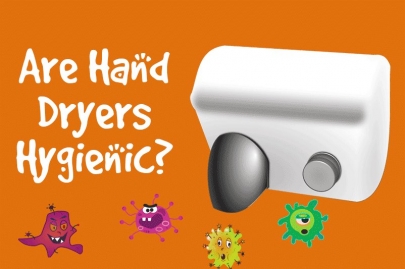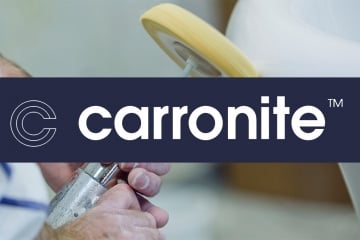Are Hand Dryers Hygienic?

Are Hand Dryers Hygienic
Over the past decade, there has been a great deal of debate about whether or not hand dryers are truly the most hygienic solution to drying your hands in a public bathroom. There have now been a number of studies that have sought to answer this question, with varying results. Some say that hand dryers are more hygienic as they minimise physical contact while others claim that the warmth and airflow generated actually encourage the growth and spread of bacteria.
There are three popular methods of hand drying in public bathrooms. These methods are: drying using paper towels (and sometimes linen towels, in fancy bathrooms), warm air dryers and newer, more advanced jet air dryers. Warm air dryers are currently more widespread, the type you might encounter in a pub or school toilet, and use warm air that is directed at a lower speed than newer models. Jet air dryers, such as Dyson's “Airblade”, blast cooler air at very high speeds, with the aim of encouraging water away from your skin.
Testing Methods
In an attempt to determine the most hygienic method of drying your hands, researchers performed a series of tests. The most important of these was a hand drying test, which took place in a standard ventilated room (without air conditioning) and involved testing both the environment and its inhabitants. People wore gloves and then dipped their hands in a solution of bacteria cultured from yogurt and then dried their hands with each of the three main methods.
To fairly test how hygienic each drying method is, researchers rubbed their hands for 15 seconds with four paper towels, rubbed their hands together under a warm air dryer for 30 to 40 seconds or used a jet air dryer for 15 seconds. These times were considered the necessary amount needed for each method to completely dry the user's hands (gloves, in this case). As the test was primarily focused on the spread of germs, 120 air samples were taken, with half of these taken after drying hands and half taken before, as control samples. Each of these samples were taken over a 15 minute period using air samplers.
A second test was performed to discover the possible spread of contamination from person to person. Researchers coated their gloves in water-based black paint and both they and a fellow test subject were dressed in white suits. The two people stood one metre apart and the researcher dried their hands to observe the transfer of paint from their hands to their surroundings. This test was performed 10 times for each of the three main drying methods.
Test Results
The drying test results showed much higher counts of bacteria when using hot air hand dryers than paper towels. Perhaps surprisingly, this count was even greater when using modern jet air dryers. The bacteria transfer test with black paint produced similar results; paper towels restricted the paint to the primary test subject, while air dryers and jet dryers both spread paint from the hands to the subject's body, as well as to anyone standing in close proximity.
An interesting feature of the hot air dryer test was that the test subject rubbing their hands together during use actually resulted in less bacteria being removed. On the other hand, holding their hands still while drying removed a greater amount, suggesting that the common practice of rubbing hands together to accelerate drying is actually detrimental. In this sense, jet air dryers can be considered more effective than hot air dryers, as they dry the hands far more quickly and discourage users from either rubbing their hands together or leaving the bathroom while they are still wet. As long as users adhere to the manufacturer's instructions and dry their hands thoroughly, there isn't a significant difference in effectiveness between the two main air dryer types.
Test Limitations
Despite this study suggesting that air dryers are inherently more hygienic than their electrical counterparts, there are definite limitations to the tests conducted. Rather than test subjects washing their hands and then drying them, they dried them without removing any of the bacteria or paint beforehand. These test conditions are more akin to using the toilet then drying the hands without washing them, which is an unlikely scenario. The results do suggest that the heat and air currents generated by an electrical dryer are likely to encourage the growth and spread of germs but the test conditions are unlikely to be replicated in everyday life. To truly test the effectiveness of each type of drying, it would be more logical to dip the gloves in bacteria, clean them with soap and water and then dry them using each of the different methods.
The testers also concluded that one of the main issues with hot air dryers is that users often do not use them for long enough. It's recommended that air dryers are used for at least thirty seconds to ensure the user's hands are dry, as opposed to the popular technique of briefly holding them under the dryer before wiping them clean on clothes. Jet air dryers make this less of an issue by drying the hands more quickly, usually in approximately half the time required by older dryers.
While the paint test results suggested that air dryers promoted the transfer of airborne germs, certainly in comparison to paper towels, it's again unclear how significant this is. Proving that specks of black paint are transferred from person does not necessarily mean that dangerous bacteria will transfer at the same rate, especially if the user has properly cleaned their hands with soap and water before drying. Black paint is heavier than bacteria, however it does replicate the scenario of transferring water from person to person, which might itself be carrying harmful bacteria.
An interesting finding of the paint transfer test was that, while specks of paint were often spread to the user's upper body and the surrounding area, both types of air dryer removed the majority of paint from the hands. Essentially, they are effective at cleaning the hands but simply transfer the bacteria elsewhere, as opposed to paper towels which are an effective disposal method. In terms of transfer, the amount of paint that landed on secondary test subjects was generally low, with little difference between the two types of air dryers.
Another question that was apparently not considered in the study is that of germ transfer from the paper towel dispenser or air dryer unit itself. While most modern units are designed to be automatic and not require any physical contact, older hot air dryers in particular are often activated by a button that can become a breeding ground for germs if not frequently cleaned. Paper towel dispensers and jet air dryers generally avoid this issue by avoiding any need for contact with the unit.
Conclusions
In any case, the results of this study support the belief that paper towels remain the most effective hand drying method for preventing the spread of bacteria, making them the recommended option in healthcare settings and anywhere else that the spread of bacteria must be minimised. While certain media sources have used these results to suggest that electrical hand dryers are somehow unsafe compared to paper towels, this isn't really true in all but the most sensitive cases and these outlets fail to mention the limitations of the tests used.
Ultimately, paper towels remain the most hygienic method of drying your hands after cleaning them. Ideally, you should activate the tap, clean your hands with warm water and soap then use a paper towel to dry your hands, then using the paper towel to turn off the tap and avoid cross-contamination, if it isn't automatic. In everyday use, there is unlikely to be any danger in using air dryers as the vast majority of people aren't carrying significant bacteria and are hopefully cleaning their hands thoroughly before drying. In more sensitive situations, for example during an outbreak of contagious illness, it remains more advisable to use paper towels to thoroughly dry the hands and then dispose of the towels. This should minimise the possibility of infecting others (similar to the “catch it, bin it, kill it” campaign launched by the NHS during the swine flu pandemic in an attempt to stifle the spread of the virus).
To answer the question of whether or not hot air dryers are hygienic, this largely depends on the circumstances and whether the user fulfils the recommended drying duration. In healthcare settings and other environments where preventing the spread of bacteria is a priority, paper towels are the most effective method for drying hands. This does raise the question of paper waste, however many paper towels are now made using recycled material and paper is ultimately considered a renewable resource. For the vast majority of people, there is no danger at all in using air dryers but in locations where bacteria should be kept to a minimum, for example dental practices or retirement homes, paper towels remain the recommended option. Whatever you choose, always remember to wash your hands thoroughly with soap and warm water and then dry them properly, without rubbing them together during the drying process. Our guide explains how to wash your hands properly for maximum hygiene
Related Posts
The patented, triple-layer Carronite reinforcement system has been a staple in the bath industry for 40 years. We dig into the truth behind the strapline...
Countertop and inset basins look completely different, function quite differently in daily use, and suit different bathroom styles and practical needs. So here's how to work out which one's actually right for your space.
Choosing between floor-standing and wall-mounted vanity units should be straightforward, but it's actually one of those decisions where both options have genuine advantages and some proper drawbacks that aren't immediately obvious until you've lived with them.




